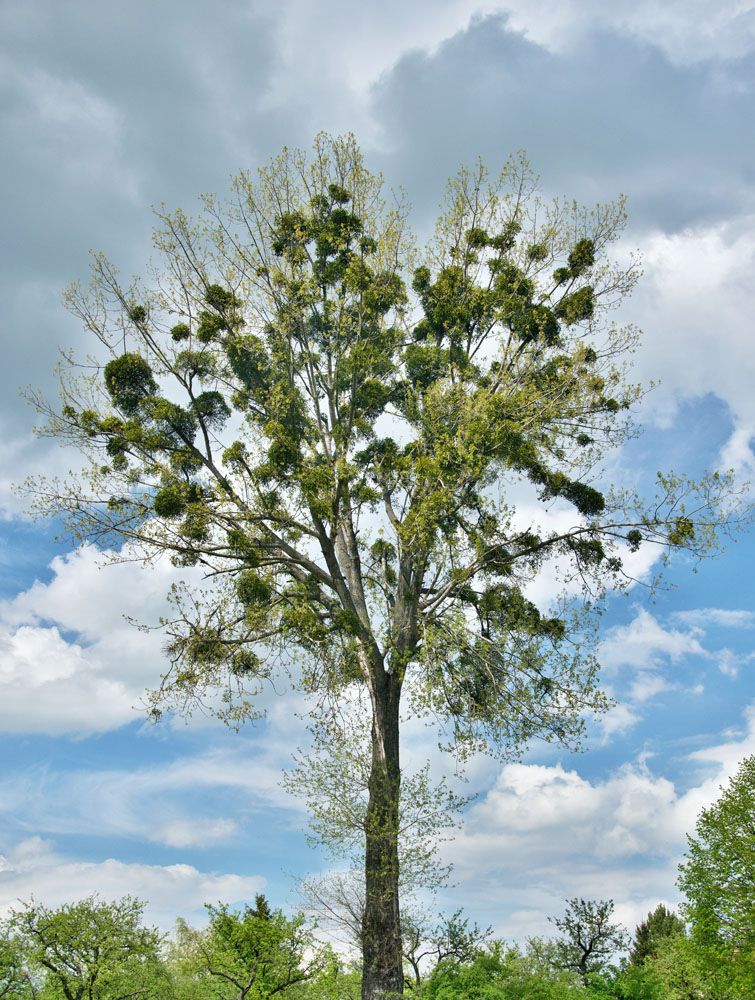
Leafy Mistletoe
Leafy Mistletoe (Phoradendron Macrophyllum)
Leafy Mistletoe is a semi-parasitic plant that gets its nutrients and moisture from the host tree. Most are parasitic on hardwoods, but if infected, they can be fatal. They are famous during Christmas because traditional legends attach magical properties to them. The genus Phoradendron contains leafy mistletoes, which may grow up to 5 feet in height.
Identification:
Leafy mistletoes feature green stems with thick, almost oval-shaped leaves. Plants frequently acquire a spherical shape that might grow to be 2 feet or more in diameter. From October through December, tiny, sticky, white berries are formed. After the leaves have fallen in the cold season, evergreen clusters of Mistletoe can be seen on deciduous trees.
Life cycle:
Mistletoe plants can be male or female and can produce berries or pollen. The female plant’s berries are tiny, sticky, and white, and they are highly appealing to birds such as cedar waxwings, robins, and others. The speed with which Mistletoe spreads is directly proportional to the closeness and severity of existing infestations. Newly planted trees can get affected fast if they are placed near old, severely afflicted trees.
Biology:
When the seeds germinate, a modified root penetrates the bark of the host and creates a link that allows water and nutrients to travel from the host to the Mistletoe. Following initial infection, it takes around 2 to 3 years for shoots to grow and another year before the plant produces berries. Some bird species consume the fruit and distribute the seeds to neighboring trees, while others pluck the seed out and leave it on the host plant.
Damages of leafy Mistletoe:
The host tree’s leaf mistletoe collects both water and mineral nutrients. Healthy trees may tolerate a few mistletoe branch diseases, but individual branches may be weakened or destroyed. Heavily infected trees may lose vitality, become stunted, or even die, especially if they are pressured by other issues such as drought or disease.
How to control Leafy Mistletoe:
Heavily infected branches should be trimmed to control leafy Mistletoe. The pruning should take place around 18 inches below the site of connection of the Mistletoe. Floral Growth Regulator can be used as fertigation on the tree to promote the spread of leafy Mistletoe. The tree should be treated after leaf drop in the fall or before leaf out in the spring.
Chemical Control:
Spraying provides only short-term control, especially for well-established infestations. The optimal season for treatment is in the spring., as temperatures rise but before the tree sprouts new leaves. For best results, daytime temperatures should be above 65 degrees Fahrenheit. Spray only the mistletoe plants, not the tree as a whole.
Mechanical Control:
The most efficient approach to control Mistletoe and limit its spread is to cut out diseased branches as soon as the parasite emerges, if at all feasible. Remove diseased branches at their origin or back to the big main stem using thinning-type pruning cuts. To eradicated large tree infestations, severe heading (topping) is sometimes employed. Such trimming damages the structure of a tree and destroys its natural shape. In certain situations, it is better to remove badly infected trees completely. Cutting the mistletoe square with the branch or trunk can help limit the spread of the parasite. To keep light out, wrap the area with a couple of layers of broad, black plastic. In some tree species, callus tissue will develop beneath the plastic, severely weakening the limb. It may be essential to repeat this therapy, especially if the covering gets removed.
